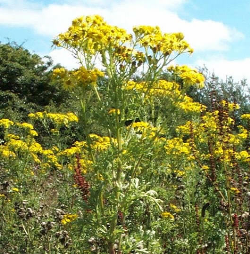
Beware of yellow peril ragwort as behind the pretty petals is a lethal menace that can be fatal to animals and harmful to humans.
Many people are unaware of the dangers that ragwort poses and Lake District National Park Authority ranger manager Shirley Muir points out while horses are particularly vulnerable to poisoning, farm animals and wildlife are susceptible too.
"Ragwort is one of the most frequent causes of livestock being poisoned by plants in Britain," she said. "It can even enter humans' bloodstream through the skin and protective clothing must be worn when handling it."
Each plant can produce up to 150,000 seeds, with a 70 per cent germination rate, and ragwort poisoning can happen at any time of the year. The toxins act cumulatively, eventually destroying the liver.
"Pulling, digging and spraying must continue annually and the plants should be taken out of harm's way," said Shirley. "Cutting should only be done in emergencies to prevent reseeding."
John Spedding, of Mirehouse estate, near Keswick, said: "If this harmful weed is to be controlled, everybody should play their part. One garden full of ragwort in a windy area can cause untold damage."
The estate employs contractors to deal with the plant in its woods, but Mr Spedding explained he does most of the pulling nearer to the house and has a "keen eye for spotting the yellow menace at a long distance".
Under the 1959 Noxious Weed Act landowners have a responsibility to remove it from their own land. In cases where they do not, government agencies can step in - and make a charge.
Cumbria County Council said: "When we receive a specific complaint of ragwort growing at a defined location where we are responsible, we investigate the scale and nature of the problem and, where appropriate, eradicate the weed by pulling, cutting, burning or using chemical control."
